WARM UP
Stretch and Roll Out:
Wrists/Forearms
Chest
Traps
Back
Lats
Hips/Glutes
WORKOUT
Complete 1 rounds of the first circuit. Then complete 2-3 rounds of the second circuit before moving on to 3-5 rounds of the third circuit. Only rest between rounds of the third circuit. Rest up to 1 minute between rounds.
CIRCUIT #1:
10-15 reps Thoracic Extension (Roller)
10-15 reps each side Kneeling Thoracic Extension
10-15 reps each side Child’s Pose with Reach
10-15 reps each side Corkscrews
10 reps each side 3-Way Neck Stretch
CIRCUIT #2:
30 seconds – 1 minute Dead Hang
30 seconds – 1 minute Cobra Hold
30 seconds – 1 minute Side Planks
CIRCUIT #3:
30 seconds – 1 minute Lying Scapular Hold
8-15 reps per side One Arm Dumbbell Row
5-10 reps each way Y-T-W-Ls
COOL DOWN
Stretch and Roll Out:
Wrists/Forearms
Chest
Traps
Back
Lats
Hips/Glutes
NOTES:
While this workout is a good start to getting rid of your minor neck and shoulder aches and pains, you need to stretch and roll out more than once a week.
EXERCISE DESCRIPTIONS:
Thoracic Extension (Roller) – With the roller in your upper back, drop your butt down to the ground and then lean back over the roller, trying to drop your head to the ground behind you. Change where the roller is in your upper back (moving it down or up) and then drop your butt to the ground and extend back over again. Work all the way up and down your upper back.
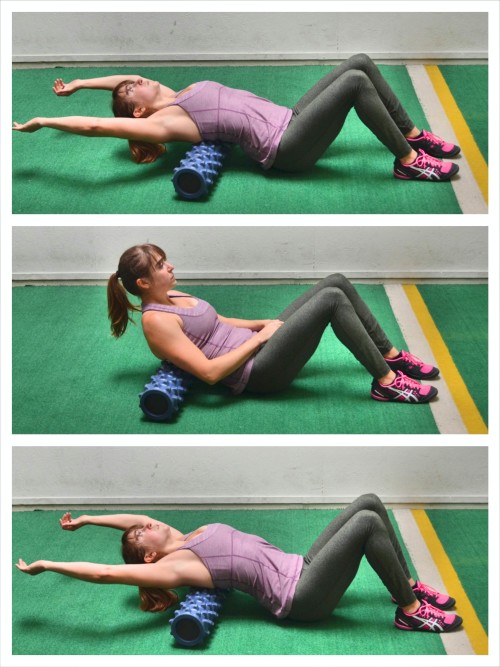
Kneeling Thoracic Extension – On your hands and knees, reach one hand down your neck and spine. Fingertips should be pointing down your back toward your butt. Then rotate your core so that your elbow goes under your arm on the ground. Then rotate open driving the elbow up toward the ceiling. Try to focus on just opening up your back and not really shifting your weight in your lower body. Then rotate back closed and repeat.
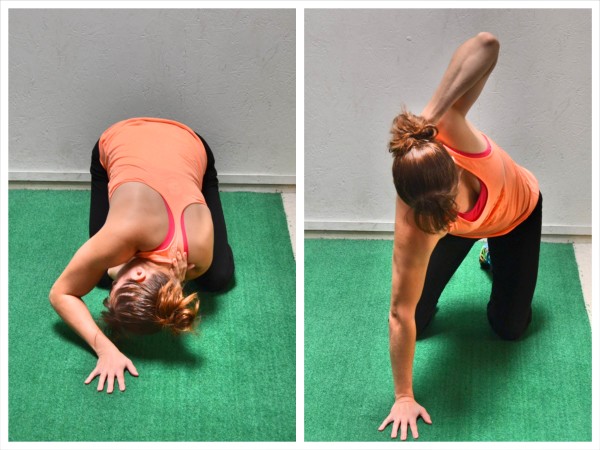
Child’s Pose with Reach – Kneel on the ground with your toes pointed. Sit back on your heels reaching your arms out on the ground overhead. Walk your hands out as far as possible. Then walk your hands to the right as far as you can and then to the left to get more of a stretch down each side of your back. Make sure you continue to sit back and relax over as you walk your hands. You should feel this stretch down your arms and the sides of your back. You should also feel the stretch in your low back if you are relaxing back onto your heels.

Corkscrews – Standing with your feet about hip-width apart, bring your arms up to shoulder height with your thumbs pointing forward. Then rotate your left hand, pointing the thumb down and then backward so that your palm is facing up. Your whole arm should rotate and the shoulder should rotate forward. As you rotate the left thumb down and back, turn the right thumb up and back so the right palm is also facing up. You should be rotating the right shoulder back and open. Your body should also turn and open a bit to the right. Then switch hands, rotating your body a bit to the left as your left shoulder rotates back and your right shoulder rotates forward. Keep alternating till all reps are complete.
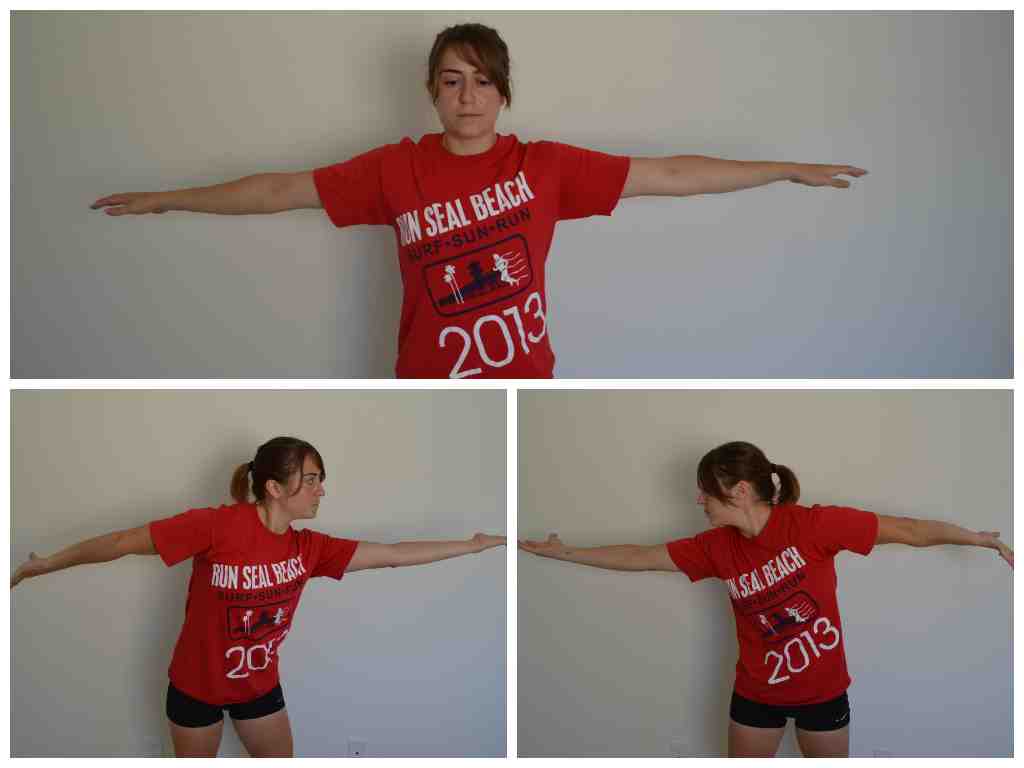
3-Way Neck Stretch – Reach one hand behind your back and then grab that wrist with the other hand. Pull the arm behind your back toward the opposite side. Then lean your head to the side you are pulling to. Do not tense your shoulders and bring them up toward you ears. Relax into the stretch. Then change the direction of your gaze. Look up and hold for a second or two. Then look straight ahead. And then look down. Move your chin as you look and not just your eyes. Changing the direction of where you look, will change exactly which muscles in your neck and upper back that you stretch.
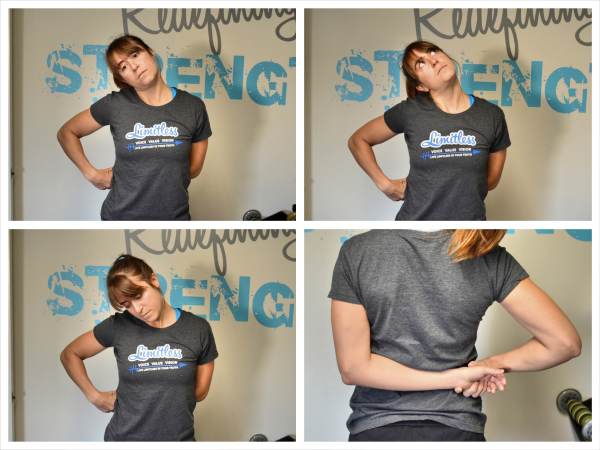
Dead Hang – Hold on to a pull up bar or suspension trainer and hang from the bar. Your hands can be facing toward you or away from you. As you hang, do not let your shoulders shrug up. Keep your chest pressed out and your core tight. Your legs should hang down toward the ground. Do not tuck your knees up toward your chest.
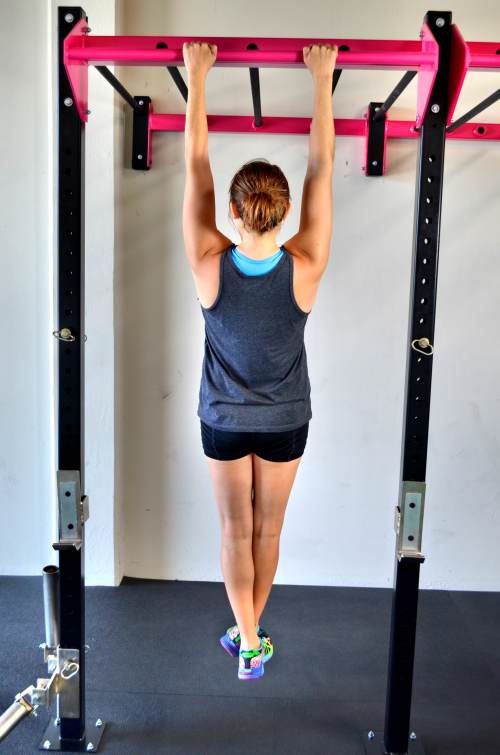
Cobra Hold – Lie face down on the ground with your arms down by your sides and your legs straight out. Your palms should be facing up. Then lift your chest up as high off the ground as you can, pinching your shoulder blades down and back. Keep your head in line with your spine as you lift. Squeeze your glutes so you don’t feel this straining your low back. Hold at the top, keeping your chest as high off the ground as possible. More advanced exercisers may want to hold light weights in their hands. Do not let your shoulders shrug.
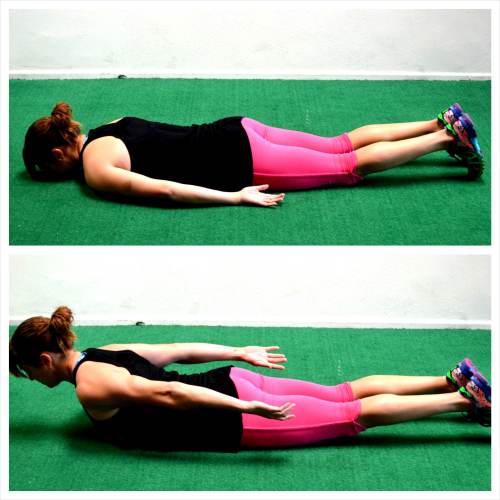
Side Planks – Set up on your side. Prop yourself up with your forearm right below your shoulder. Beginners will do this move from their forearm and knees or knee while more advanced exercises may do this from their forearm or hand and toes. Whichever variation is right for you, make sure to lift your bottom hip up off the ground as high as possible while keeping your body in a nice straight line. Squeeze your belly button in toward your spine and keep your glutes tight. Do not let your chest rotate forward toward the ground or your top hand touch the ground. Keep your top hand on your hip or reach it up toward the ceiling. This move can be advanced further if you lift your top leg up off your bottom leg.
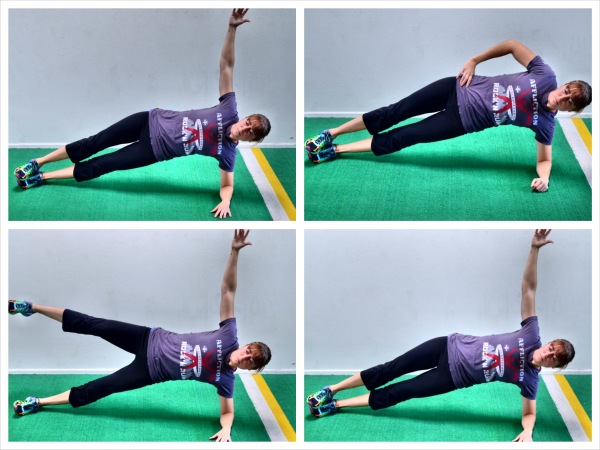
Lying Scapular Hold – Lie face down on a bench with your legs out straight behind you and your arms hanging down toward the ground. Bend your elbows to about 90 degrees. Advanced exercisers may grab weights on the ground. Then drive your elbows back and draw your shoulder blades down and together. Squeeze your glutes to protect your low back. You should feel this low between your shoulder blades. Hold at the top, pinching your shoulder blades together and driving your elbows back. Relax your head and neck as you hold. Do not shrug your shoulders.
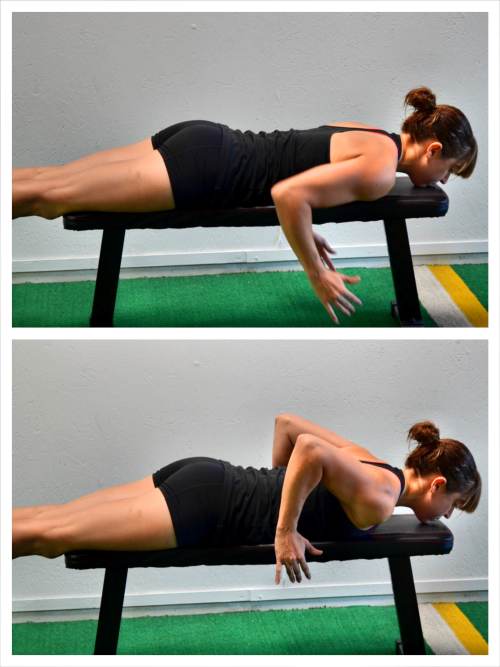
One Arm Dumbbell Row – To do this move, you can simply hinge over or you can hinge over and place your hand on a table, chair, bench or box. Keep your knees slightly bent. You can stand with your legs together or in a staggered stance. Hinge over, pushing your butt back. Your back should stay nice and flat as you lean forward. Extend the arm with the dumbbell down by your side. Place your other hand on the bench for support. Do not let your arm with the dumbbell pull your body toward the ground and round your back . Keep your back flat and don’t reach. Then row the dumbbell up toward your chest, keeping your arm in tight to your body. Drive the elbow up to the ceiling, rowing the weight in right below your pec. Do not shrug your shoulder. Then slowly lower the weight back down. Do not let your back round or try to reach to get the weight closer to the ground as you lower. Complete all reps on one side before switching.
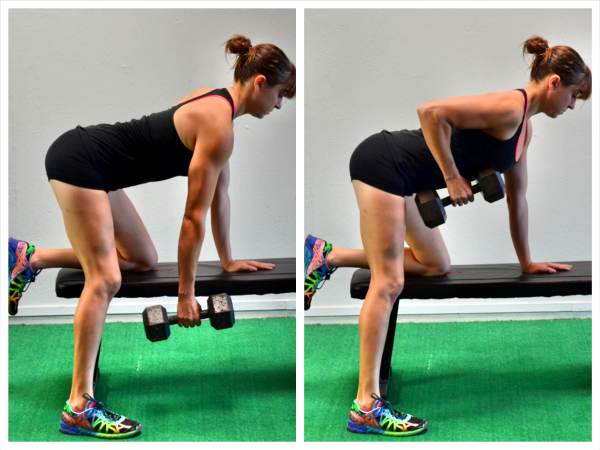
Y-T-W-Ls – Lie on the ground or over a stool or bench. Keep your low back relaxed. You want to feel this in your upper back behind your shoulders and in between your shoulder blades. None of these are really big movements. To do a Y, your thumbs should be pointing toward the ceiling and your arms should be above your head in the shape of a Y with your body. Lift up, using the muscles in your upper back. To do a T, have your thumbs pointing up toward the ceiling. Your arms should make a T with your body. If you are doing this on the ground, you are really only going to lift an inch or two off the ground. Over a bench or stool, you may be able to relax further down. To do a W, bend your elbows to create a W with your body. Your thumbs should be pointing in toward you. Lift and lower. The final move, the L, will be done two different ways depending on where you do it. If you are lying on the ground, you will set up with your elbows bent to 90 degrees and your elbows in line with your shoulders. Palms facing the ground, try to rotate the backs of your hands toward your toes. Then relax. If you are doing this from a stool or bench, you will actually start with your arms handing toward the ground. You will then lift your arms, bending your elbows to 90 degrees. Then keeping the elbows bent, you will rotate the backs of your palms toward the ceiling. None of these moves involve a big range of motion. Do not rush through the movements. Complete all of one movement before switching to the next.